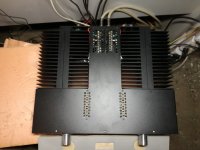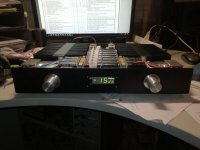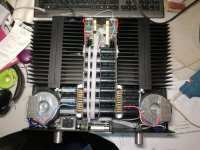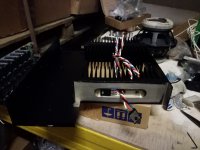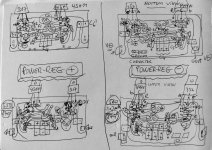Daniel, nice to see the LM350K used as prereg, if I see it right.
Question: why use the relais in the output, the Monstre never at any moment has a DC
- oops except of course when you have a tube preamp like I did, it once costed me a Fostex 103 🙁
Question: why use the relais in the output, the Monstre never at any moment has a DC
- oops except of course when you have a tube preamp like I did, it once costed me a Fostex 103 🙁
Hi All,
I am using the LM338K's and they seem to provide very good regulation and low noise prior to the large capacitor bank.
The output relay is for dc protection.
This amp operates from DC to afew hundred kHz 😉
Sorry to hear about the Fostex 103 !
-Dan
I am using the LM338K's and they seem to provide very good regulation and low noise prior to the large capacitor bank.
The output relay is for dc protection.
This amp operates from DC to afew hundred kHz 😉
Sorry to hear about the Fostex 103 !
-Dan
is there a chance to find the original transistors now-days?
You may try here, but I don't if they are fake or not:
LittleDiode
Hi All,
would you please share the up-to-date replacements for transistors. I'm going to build the amp and already have matched pairs of FETs. And aone more question - how is the sound of the amp compared to Apex A9 or A14 amp?
would you please share the up-to-date replacements for transistors. I'm going to build the amp and already have matched pairs of FETs. And aone more question - how is the sound of the amp compared to Apex A9 or A14 amp?
Last edited:
Hi All,
would you please share the up-to-date replacements for transistors. I'm going to build the amp and already have matched pairs of FETs
Hi!
For me, the 2SC2240 and it's complementary 2SA970 works just wonderfully. My power transistors are the Sanken 2SC1116 and it's complementary 2SA747.
Hi!
For me, the 2SC2240 and it's complementary 2SA970 works just wonderfully. My power transistors are the Sanken 2SC1116 and it's complementary 2SA747.
Thank you. Any other suggestions? And what about sound comparisson with Apex A14?
Thank you. Any other suggestions? And what about sound comparisson with Apex A14?
Well, some say the BC546 and BC556, and the BD139 and BD140 works just fine, but i am not sure. I can't compare it to the A14, but i can compare it to the JLH 10W, the TDA2050, the TDA7294, the STK-056. For me, this amp is better than all of these, because it produces a very natural sound. When you listen to it, it feels like a plug was removed from your ears. This is the best description i can give.
original parts
Are you sure these are the original parts of the Monstre? Hiraga was very fuzzy about parts and did a lot of testing and hearing (as stated in the articles at the time).
- cosmos pot from japan (very expensive, like €20 for 1 pot, yours seems to be Bourns?).
- white cement power resistor on pcb, don't know make (yours is green).
- caps on pcb were tantalum
- no toriodal transformer but some block-formed one.
- 1 Farad of buffer of brand so and so
- special brand of cable for inside wiring
etc etc it's all in the original articles.
I don't say you have to use the same components as Hiraga, it is virtually impossible these days.
BTW I have built tens of Monstres during my life. Some completely original and most with variations. It seems to matter but you have to try for yourself what suits you (not being happy too soon). For me the 20Watter was easier to build to the same standards with other components, this one seems to be more forgiving in character soundwise.
For the Monstre he used the same parts as used for 20Watt version:
Are you sure these are the original parts of the Monstre? Hiraga was very fuzzy about parts and did a lot of testing and hearing (as stated in the articles at the time).
- cosmos pot from japan (very expensive, like €20 for 1 pot, yours seems to be Bourns?).
- white cement power resistor on pcb, don't know make (yours is green).
- caps on pcb were tantalum
- no toriodal transformer but some block-formed one.
- 1 Farad of buffer of brand so and so
- special brand of cable for inside wiring
etc etc it's all in the original articles.
I don't say you have to use the same components as Hiraga, it is virtually impossible these days.
BTW I have built tens of Monstres during my life. Some completely original and most with variations. It seems to matter but you have to try for yourself what suits you (not being happy too soon). For me the 20Watter was easier to build to the same standards with other components, this one seems to be more forgiving in character soundwise.
For the Monstre he used the same parts as used for 20Watt version:
I build the Hiraga 8W class A amplifier some 30 years ago using the original parts. At that time the power transistors I received were already surface viped to hide the part numbers!
It still sounds really good having more than enough power for normal listening. I even used it at parties together with some home made JBL based PA speakers.
A few more pictures from the project are found on this Norwegian forum.
PCB close-up:
View attachment 639716
Simple solutions also work! PCB was made with ink pen... 🙂
View attachment 639715
Amplifier chassis using an old main frame power supply:
View attachment 639714
Party speakers:
View attachment 639718
le class
Wow a great deal of thought put into this build. Nice, Whats the specs? How much capacitance in total do you have etc.
First Build of the le monstre, power supply ideas?
Hi to all my DIY Hiraga family out there! I decided to build this amplifier as it is popular and there are many kits available, plus it's not too expensive to build.
Please see attached schematics.
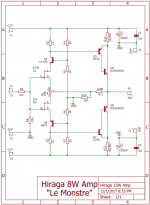
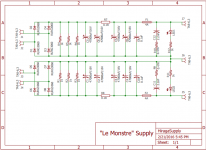





So far i have bought 16x25v@47000uf capacitors, i also have two toroidal transformers 160va 2x12v 6.67A.
I have a few questions about the power capabilities of this amplifier, now i know it runs at 12V and i know that probably after rectification and going thought the capacitors the voltage will increase, so what i want to know is . will this be ok? Can these amp boards take the high voltage? If not what would you suggest i change in terms of components to handle the extra voltages? Or will it be ok?
I'm not fussed if it's 8w or 15w, i just want to learn how to set it all up i.e the bias and to get it sounding as good as i can with what i have.
Would i need a soft start and speaker protection modules? I will be building the chassis and heatsinks myself!
Any tips would be greatly appreciated.
Thanks
V
Hi to all my DIY Hiraga family out there! I decided to build this amplifier as it is popular and there are many kits available, plus it's not too expensive to build.
Please see attached schematics.







So far i have bought 16x25v@47000uf capacitors, i also have two toroidal transformers 160va 2x12v 6.67A.
I have a few questions about the power capabilities of this amplifier, now i know it runs at 12V and i know that probably after rectification and going thought the capacitors the voltage will increase, so what i want to know is . will this be ok? Can these amp boards take the high voltage? If not what would you suggest i change in terms of components to handle the extra voltages? Or will it be ok?
I'm not fussed if it's 8w or 15w, i just want to learn how to set it all up i.e the bias and to get it sounding as good as i can with what i have.
Would i need a soft start and speaker protection modules? I will be building the chassis and heatsinks myself!
Any tips would be greatly appreciated.
Thanks
V
Hi to all my DIY Hiraga family out there! I decided to build this amplifier as it is popular and there are many kits available, plus it's not too expensive to build.
Please see attached schematics.
View attachment 664201
V
If I were to build this famous amp my Aquarius ascendant would force me to introduce some mods:
1) Choose higher power rails, anything from +/- 15VDC to +/-24VDC.
2) Use Power Regulator (in my case the PowerReg from Teddy Pardo) to save money on power caps. Of course, I would also use my other PS secret weapon: the "charge-transfer supply" from -ECdesigns-
Introducing the PowerReg | pink fish media
3) Cascode also the outputs with BJT. Given the higher power rails, no loss on headroom.
4) For the ultimate sound quality: do a cascoded common-source VFET output, but that would need another higher power rail for the bias.
At the moment I am totally busy with multiple projects but this one is in my "to do" list.
Best of lucks.
M.
Attachments
Here is my built. Enclosure work done by me. All PCB's purchased as a kit.
Here is the link of my drive folder in which i have stored all the built photos, might help someone to get ideas to built an enclosure.
Le Monstre - Google Drive
Sadik
An externally hosted image should be here but it was not working when we last tested it.
An externally hosted image should be here but it was not working when we last tested it.
An externally hosted image should be here but it was not working when we last tested it.
An externally hosted image should be here but it was not working when we last tested it.
An externally hosted image should be here but it was not working when we last tested it.
An externally hosted image should be here but it was not working when we last tested it.
An externally hosted image should be here but it was not working when we last tested it.
An externally hosted image should be here but it was not working when we last tested it.
An externally hosted image should be here but it was not working when we last tested it.
An externally hosted image should be here but it was not working when we last tested it.
Here is the link of my drive folder in which i have stored all the built photos, might help someone to get ideas to built an enclosure.
Le Monstre - Google Drive
Sadik
Very Nice to see, are the front and back panels perspex? How did you get the etching onto it (the labels) and is the metal work sprayed or anodised?
Thanks
Thanks
The front and back are acrylics, laser cut & engraved. Top and bottom plates including the internal one is aluminum. They all are anodized including the heat sinks.
Sadik
Sadik
Congrats on your amp, it really looks great.
If you get a chance you could add some extra protection like thermal switchs: one on each heatsink and a speaker protection module.
Are you thrilled with the sound ? I really like mine.
BR
Eric
If you get a chance you could add some extra protection like thermal switchs: one on each heatsink and a speaker protection module.
Are you thrilled with the sound ? I really like mine.
BR
Eric
I have added thermal switches as well as speaker protection module. You can see the sensors fitted on heat sink and speaker protection board on back side of soft start module (5th Pic). The Sound is too good to be described.
Sadik
Sadik
Here is my built. Enclosure work done by me. All PCB's purchased as a kit. <snip>
Nice built !
One question: you seem to have Capacitance multipliers for PSU which also appears to include rectifier diodes. This is nice to have all on the same pcb. Do you have more information on this Pcb!
Thanks in advance
Fab
- Home
- Amplifiers
- Solid State
- Hiraga "Le Monstre"

